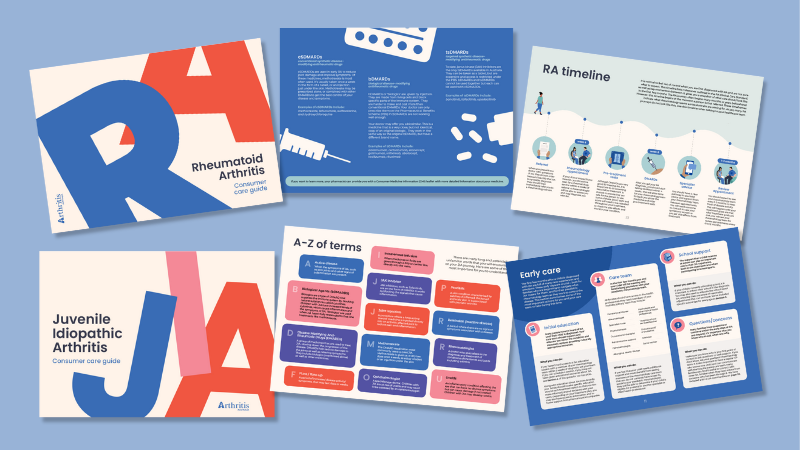Understanding RA Disease Progression
Signs, Symptoms and Management Strategies
Each person with RA is unique. The disease can vary greatly from person to person. Though some people have periods of long remission and some have symptoms that come and go, most people with RA have progressive disease. This means their RA gradually and consistently worsens over time.
According to the CDC, early diagnosis and treatment (within six months of experiencing symptoms) can play a role in keeping RA in a period of remission. However, some people with RA will have progressive symptoms even with treatment.
Progressive RA Risk Factors
Whether or not your RA will progress depends on many factors, such as:
- How advanced your RA is when you’re diagnosed
- Diagnosis at a younger age
- Intense or long-lasting flares
- Bumps called nodules are present under the skin
- Inflammation is detectable through blood tests
- High levels of rheumatoid factor (an antibody detectable with a blood test)
Physical Impact
As RA progresses, joint pain, swelling and stiffness become the main symptoms, particularly in the hands and fingers. Inflammation, which also worsens, can cause the joints to feel warm to the touch. Daily activities such as getting dressed, walking or opening jars may become more difficult. RA can progress to the point of joint deformity, severely limiting the ability to perform daily activities. Over time, the pain and inflammation can become disabling. As RA progresses, other areas of your body can also be affected, such as:
- The cartilage that cushions joints starts to wear away.
- The ligaments and tendons that hold joints together can lose their strength and function.
- Lumps called nodules may form under the skin of the fingers, spine, heels or elbows.
Psychological Impact
Depression is common among people with chronic illnesses such as progressive RA. In fact, people with RA have twice the risk of being depressed versus people who don’t have the disease. Depression can cause an increase in pain and makes it harder to live with RA.
“Many people assume they can handle the depression on their own, not recognizing that depression is actually a part of the disease of RA and tends to worsen without treatment,” said Dr. Laurie Ferguson, psychologist and Vice President for Education, CreakyJoints. “When a person with RA is progressing, getting some type of emotional support is key. Depression is not something to go through alone.”
If you feel sad, anxious or have feelings of hopelessness, it’s important to discuss these feelings with your doctor. Anti-depressant medication and/or talk therapy with a therapist who is experienced in working with people with chronic illnesses can be helpful. Support groups in which you share your feelings with others who have similar experiences can also help you feel less depressed. In addition, exercise can be very beneficial in improving overall mood.
Treatment Options
Drug therapy plays an important role in controlling the progression of RA. Most commonly, anti-inflammatory medications are used for inflammation and swelling, while disease-modifying and biologic drugs are designed to slow the progression of RA. In the past, doctors tended to treat RA with pain relievers and physical therapy first, prescribing stronger medicines only if the disease worsened. Now many doctors believe early treatment with more powerful drugs may limit the progression of RA and slow or even stop joint damage.“We know that if we wait to treat RA patients until we see disease progression, it is much harder to achieve remission,” said Dr. Jonathan Krant, Chief of Rheumatology for Adirondack Health Systems and medical director, Global Healthy Living Foundation. “We treat patients early in the course of their disease with combination therapies (biologics and disease modifiers), as these have different effects on RA.”
If you have symptoms of RA, it’s important to see a doctor so you can receive an accurate diagnosis and begin treatment promptly. Once you are diagnosed with RA, your doctor can monitor your disease to determine whether or how quickly it is progressing using a variety of tools and tests. These include tests that assess the objective elements of disease response, such as joint tenderness, and tests that measure non-objective elements, including questionnaires that ask patients to rate their pain and difficulty performing daily activities.
Lifestyle Changes
Lifestyle changes can play an important role in managing progressive RA. Daily exercise helps reduce fatigue, strengthen the muscles that support the joints, and improve flexibility and range of motion. A physical therapist can help design a program that is best for you while reducing your risk of injury. Diet has been shown to help reduce RA symptoms in some people. In particular, omega 3 fats found in walnuts, flaxseeds and fish such as salmon and sardines are believed to reduce inflammation in the body. Before beginning any dietary or exercise regimen, talk to your doctor to find the best treatment plan for you.





